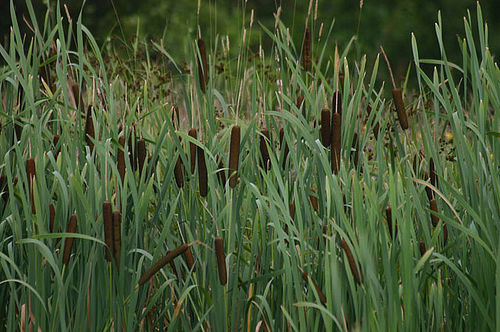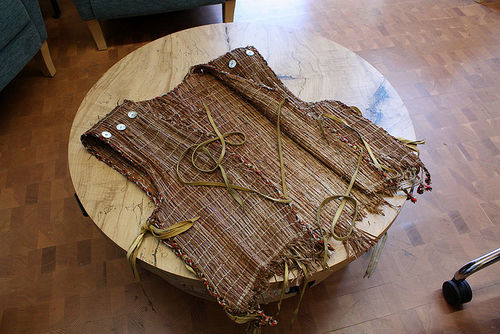Cattail Chemurgy
Nature Bulletin No. 416-A April 24, 1971
Forest Preserve District of Cook County
George W. Dunne, President
Roland F. Eisenbeis, Supt. of Conservation
CATTAIL CHEMURGY One of the remarkable things about the primitive American Indians was their use of innumerable plants for food, clothing, shelter, medicines and implements. The early settlers learned a lot from them but, as civilization progressed, much of that knowledge was abandoned and forgotten. Now a new science, called "chemurgy", is discovering that some of our abundant but neglected plants have undreamed-of possibilities. One of these is the common Cattail.
This is the familiar plant with erect strap-like leaves from 4 to 8 feet tall and, above them on a slender stalk, the cylindrical flower-head which is green and velvety in early summer when it resembles a cat's tail. The upper part contains the male flowers which drop off after they have bloomed and shed their pollen. The larger lower part contains the female flowers which develop into a brown plushy compact mass of as many as 300,000 very tiny seeds, each with a tuft of fine white hairs, that are spread by winds when the head opens in autumn.
It grows in marshes and wet places. In the Chicago region, near Wolf Lake and Lake Calumet for example, there are thousands of acres covered with dense stands of cattails. A war-time survey showed that there are at least 140 thousand square miles of cattail swamps in the United States.
One Indian name for the cattail meant "fruit for papoose's bed" because the fluffy masses of seeds are very soft and do not mat. During World War II, several million pounds of them were used to stuff life jackets, mattresses, pillows and baseballs. Compressed into wallboard, they make excellent insulation against sound and heat. A drying oil similar to linseed, a cooking oil and a wax can be extracted from the seeds, leaving a by-product of meal which is used in cattle and chicken feeds.
For centuries, cattail leaves have been used to caulk barrels, and twisted or braided into cords for making rush-bottomed furniture. The Indians wove them into waterproof mats for the sides of their lodges, and sleeping mats on their travels. Soft fibers, extracted from the leaves and stems by treating them chemically, can be used like jute for stuffing furniture and making twine, burlap or webbing. A stickly substance extracted from the stems may have value as an adhesive for paper, as sizing, or in facial and shaving creams.
The core of the thick branching rootstock, which grows horizontally in the mud, is very starchy. It can be cooked and eaten like potatoes, or dried and ground into flour used in baking and also as a substitute for corn starch. This flour can be fermented to produce ethyl alcohol valuable as anti-freeze, as a cheap industrial solvent, and for medicinal purposes. It contains more fat but slightly less protein than potato or wheat flours, and only potato flour has more minerals .
Some Indians made jelly from the rootstocks and they can be used for marmalade. In spring the young shoots, which taste something like a cucumber and are called "Cossack asparagus", are peeled and eaten as a vegetable or in salads. The young green flower-heads are said to be delicious when boiled or roasted. The pollen, which is very abundant and rich in vitamins and minerals, was harvested and used in bread by our American Indians.
Cattail marshes furnish nesting places and ideal cover for red-winged and the yellow-headed blackbirds, marsh wrens, rails, bitterns, coots and some kinds of ducks. The rootstocks are important food for wild geese and our most valuable furbearer, the muskrat, which uses the leaves to build its lodges.
In late summer, the flower-head looks like a "hot dog" on a stick.
(source: Argonne National Laboratory, Division of Educational Programs)
Links
- insert link

